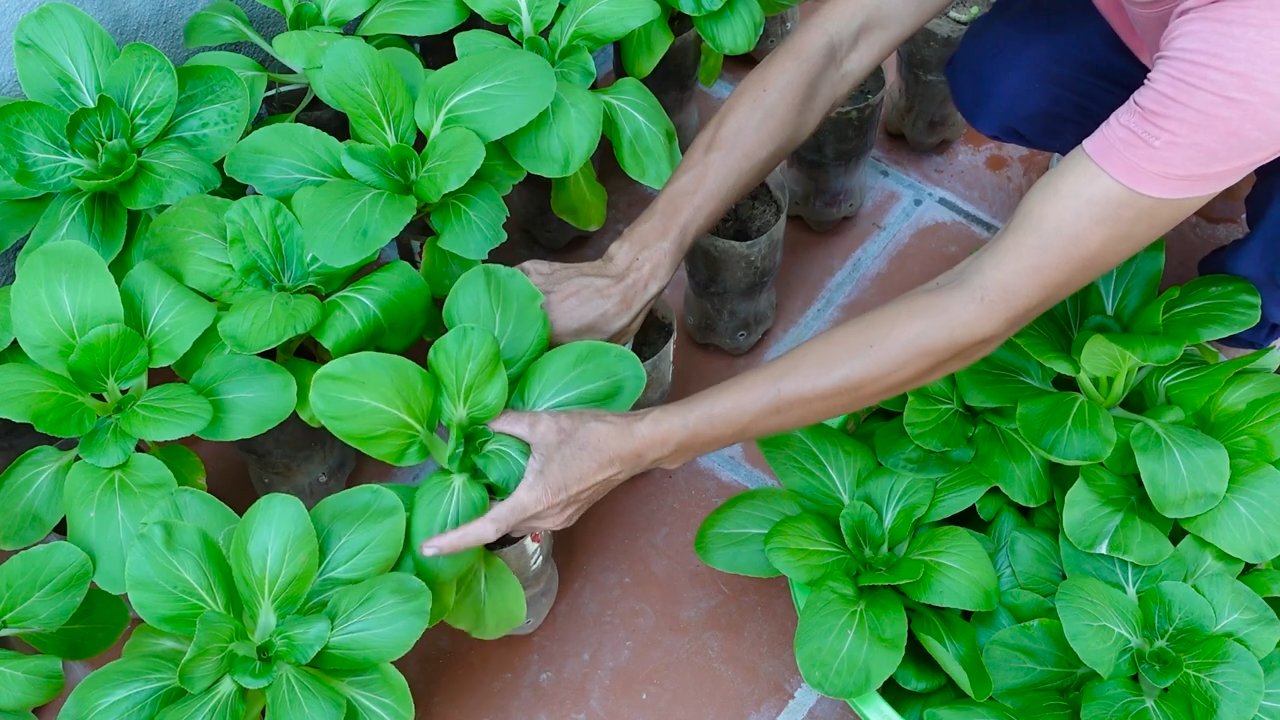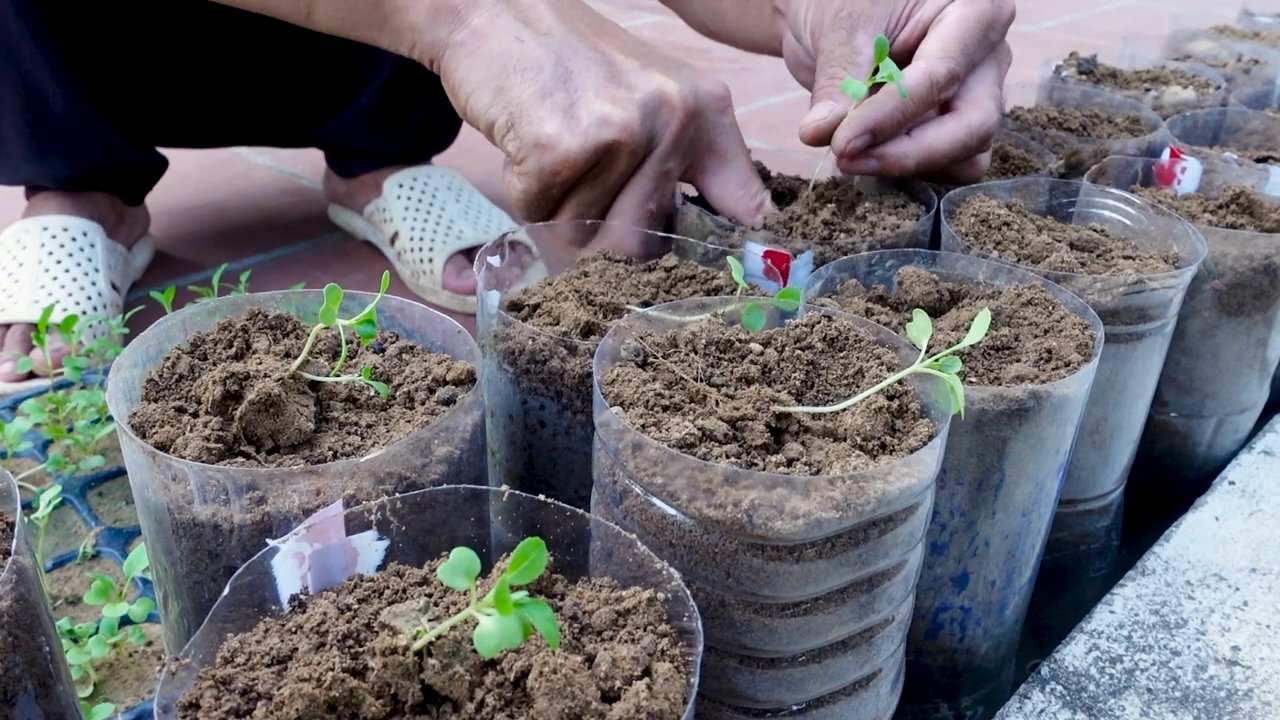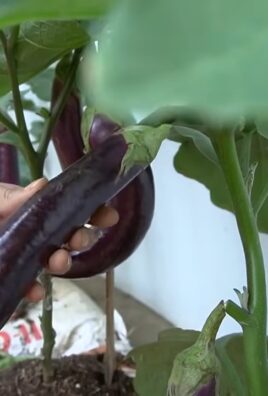Landless Vegetable Gardening: Imagine harvesting fresh, juicy tomatoes and crisp lettuce right from your balcony, even if you don’t have a sprawling backyard! Sounds like a dream? It doesn’t have to be! For centuries, humans have sought innovative ways to cultivate food, from the hanging gardens of Babylon to the ingenious floating farms of Southeast Asia. This DIY guide unlocks the secrets to growing your own delicious produce without ever touching a patch of soil.
In today’s world, where urban spaces are shrinking and access to fresh, affordable produce can be a challenge, landless vegetable gardening offers a practical and rewarding solution. Whether you’re a seasoned gardener looking to experiment or a complete beginner with limited space, these simple tricks and hacks will empower you to create a thriving edible oasis. I’m excited to share these easy-to-follow steps that will transform your patio, balcony, or even a sunny windowsill into a vibrant source of healthy, homegrown vegetables. Let’s get started and discover the joy of landless gardening together!

Landless Vegetable Gardening: Grow Your Own Food Anywhere!
Hey there, fellow gardening enthusiasts! Ever dreamed of having a lush vegetable garden but lack the space, or maybe even the land itself? Well, fret no more! I’m going to walk you through the wonderful world of landless vegetable gardening. It’s easier than you think, incredibly rewarding, and perfect for apartment dwellers, balcony gardeners, or anyone looking for a unique and efficient way to grow their own food.
This guide will cover everything you need to know to get started, from choosing the right system to nurturing your plants to a bountiful harvest. Let’s get our hands dirty (well, not really, since it’s landless!) and dive in!
Choosing Your Landless Gardening System
Before we start planting, let’s explore the different landless gardening methods available. Each has its own pros and cons, so choose the one that best suits your space, budget, and gardening experience.
* Hydroponics: This is probably the most well-known landless method. Plants are grown in nutrient-rich water solutions without soil. There are several hydroponic systems, including:
* Deep Water Culture (DWC): Plant roots are suspended in an aerated nutrient solution. It’s simple and relatively inexpensive to set up.
* Nutrient Film Technique (NFT): A thin film of nutrient solution flows continuously over the plant roots. It’s efficient but requires a pump and careful monitoring.
* Ebb and Flow (Flood and Drain): The growing tray is periodically flooded with nutrient solution and then drained. It’s versatile and can be used for various plants.
* Drip Systems: Nutrient solution is slowly dripped onto the plant roots. It’s water-efficient and easy to automate.
* Aquaponics: This is a symbiotic system that combines aquaculture (raising fish) and hydroponics. Fish waste provides nutrients for the plants, and the plants filter the water for the fish. It’s a sustainable and fascinating method.
* Container Gardening: While technically using a growing medium, container gardening is still considered landless because you’re not planting directly in the ground. You can use pots, raised beds, grow bags, or even repurposed containers.
* Vertical Gardening: Perfect for small spaces, vertical gardens utilize walls or structures to grow plants upwards. You can use hanging planters, stacked planters, or even build your own vertical garden system.
For this guide, I’m going to focus on **container gardening** and a simple **Deep Water Culture (DWC) hydroponic system**, as they are both beginner-friendly and relatively easy to set up.
Container Gardening: A Simple Start
Container gardening is a fantastic way to ease into landless gardening. It’s versatile, adaptable, and allows you to grow a wide variety of vegetables.
Choosing Your Containers
* Size Matters: Select containers that are appropriately sized for the vegetables you want to grow. Leafy greens like lettuce and spinach can thrive in smaller containers, while larger plants like tomatoes and peppers will need bigger pots.
* Drainage is Key: Ensure your containers have drainage holes to prevent waterlogging, which can lead to root rot.
* Material Choices: Plastic, terracotta, and ceramic pots are all suitable options. Plastic is lightweight and inexpensive, terracotta is porous and allows for good aeration, and ceramic is aesthetically pleasing but can be heavy.
* Repurposed Containers: Get creative! Buckets, old tires (painted, of course!), and even fabric grow bags can be excellent containers.
Selecting Your Growing Medium
* Potting Mix: Avoid using garden soil in containers, as it can compact and hinder drainage. Instead, opt for a high-quality potting mix specifically formulated for container gardening.
* Soilless Mixes: These mixes, often made from peat moss, perlite, and vermiculite, provide excellent drainage and aeration.
* Coco Coir: A sustainable alternative to peat moss, coco coir is made from coconut husks and offers good water retention and drainage.
Planting Your Vegetables
1. Prepare Your Containers: Clean your containers thoroughly and ensure they have adequate drainage.
2. Fill with Growing Medium: Fill the containers with your chosen growing medium, leaving a few inches of space at the top.
3. Plant Your Seeds or Seedlings: Follow the instructions on your seed packet or seedling label for proper planting depth and spacing.
4. Water Thoroughly: Water the containers gently until the water drains out of the drainage holes.
5. Provide Sunlight: Place your containers in a location that receives at least 6-8 hours of sunlight per day. If you don’t have enough natural sunlight, you can supplement with grow lights.
6. Fertilize Regularly: Container plants rely on you to provide them with nutrients. Use a balanced liquid fertilizer according to the manufacturer’s instructions.
Caring for Your Container Garden
* Watering: Check the soil moisture regularly and water when the top inch feels dry. Avoid overwatering, as this can lead to root rot.
* Fertilizing: Fertilize your plants every 2-4 weeks, depending on the type of fertilizer you’re using.
* Pest Control: Inspect your plants regularly for pests and diseases. Use organic pest control methods, such as insecticidal soap or neem oil, to treat any problems.
* Pruning: Prune your plants as needed to encourage growth and remove dead or diseased leaves.
* Support: Provide support for vining plants like tomatoes and cucumbers using stakes, trellises, or cages.
Deep Water Culture (DWC) Hydroponics: A Step-by-Step Guide
Now, let’s move on to a slightly more advanced, but still manageable, landless gardening method: Deep Water Culture (DWC) hydroponics. This system is perfect for growing leafy greens, herbs, and even some fruiting vegetables.
Materials You’ll Need
* Container: A dark-colored, opaque container (like a bucket or storage tote) to hold the nutrient solution. The size will depend on the number of plants you want to grow.
* Net Pots: These are small, plastic pots with holes that allow the roots to grow into the nutrient solution.
* Growing Medium: Rockwool cubes, coco coir, or clay pebbles to support the seedlings in the net pots.
* Air Pump and Air Stone: To oxygenate the nutrient solution.
* Air Tubing: To connect the air pump to the air stone.
* Nutrient Solution: A hydroponic nutrient solution specifically formulated for vegetables.
* pH Meter: To monitor the pH of the nutrient solution.
* pH Up and pH Down Solutions: To adjust the pH of the nutrient solution.
* Seedlings: Start your seeds in rockwool cubes or another suitable medium.
Setting Up Your DWC System
1. Prepare the Container: Clean the container thoroughly. If it’s not already dark-colored, paint the outside with black paint to prevent algae growth.
2. Drill Holes for Net Pots: Drill holes in the lid of the container that are slightly smaller than the diameter of your net pots. The number of holes will depend on the size of your container and the spacing you want between plants.
3. Assemble the Air Pump and Air Stone: Connect the air tubing to the air pump and the air stone. Place the air stone at the bottom of the container.
4. Fill the Container with Nutrient Solution: Fill the container with water and add the hydroponic nutrient solution according to the manufacturer’s instructions.
5. Adjust the pH: Use the pH meter to check the pH of the nutrient solution. The ideal pH range for most vegetables is between 5.5 and 6.5. Use pH Up or pH Down solutions to adjust the pH as needed.
6. Place Seedlings in Net Pots: Gently remove the seedlings from their starting medium and place them in the net pots. Fill the remaining space in the net pots with rockwool cubes, coco coir, or clay pebbles to support the seedlings.
7. Place Net Pots in the Lid: Place the net pots into the holes in the lid, ensuring that the roots are submerged in the nutrient solution.
8. Turn on the Air Pump: Turn on the air pump to oxygenate the nutrient solution.
Maintaining Your DWC System
* Monitor the Nutrient Solution: Check the nutrient solution regularly and replenish it as needed. Change the entire solution every 1-2 weeks.
* Adjust the pH: Check the pH of the nutrient solution regularly and adjust it as needed.
* Monitor Water Level: Ensure the water level is high enough to reach the bottom of the net pots.
* Provide Light: Place your DWC system in a location that receives at least 6-8 hours of sunlight per day. If you don’t

Conclusion
So, there you have it! Landless vegetable gardening, once a concept relegated to science fiction, is now a tangible, accessible reality for anyone, regardless of their property size or soil quality. We’ve explored the simplicity and effectiveness of this method, highlighting its potential to revolutionize how we approach fresh produce cultivation.
Why is this DIY trick a must-try? Because it democratizes gardening. It empowers apartment dwellers, balcony enthusiasts, and those with challenging soil conditions to cultivate their own vibrant, healthy vegetables. Imagine the satisfaction of harvesting crisp lettuce, juicy tomatoes, or fragrant herbs, all grown in your own space, without ever having to till a single inch of land. This isn’t just about growing food; it’s about connecting with nature, fostering sustainability, and enjoying the unparalleled flavor of homegrown goodness.
Beyond the basic setup, the possibilities for customization are endless. Experiment with different container sizes and materials. Try vertical gardening techniques to maximize space and create a stunning green wall. Explore hydroponics or aquaponics for even more advanced and efficient systems. Consider companion planting within your landless garden to naturally deter pests and enhance growth. You could even integrate a small composting system to recycle kitchen scraps and create nutrient-rich compost tea for your plants.
Don’t be afraid to get creative and tailor your landless garden to your specific needs and preferences. Perhaps you want to focus on growing herbs for your favorite recipes, or maybe you’re aiming for a continuous supply of salad greens. The beauty of this method lies in its adaptability.
We wholeheartedly encourage you to embark on this exciting journey of landless vegetable gardening. It’s a rewarding experience that will not only provide you with fresh, healthy food but also connect you with the natural world in a meaningful way.
But the journey doesn’t end here! We want to hear about your experiences. What vegetables are you growing? What challenges have you encountered, and how have you overcome them? What innovative techniques have you discovered? Share your stories, tips, and photos in the comments below. Let’s build a community of landless gardeners, supporting and inspiring each other to cultivate thriving, sustainable gardens, one container at a time. Your insights could be invaluable to someone just starting out, and together, we can unlock the full potential of this revolutionary gardening method. So, grab your containers, choose your seeds, and get growing! We can’t wait to see what you create.
Frequently Asked Questions (FAQ)
What exactly is landless vegetable gardening?
Landless vegetable gardening, at its core, is the practice of growing vegetables without using traditional in-ground soil. This is achieved through various methods, including container gardening, raised beds with imported soil mixes, hydroponics (growing plants in water with nutrients), and aquaponics (combining aquaculture and hydroponics). The key is that the plants are not rooted directly into the native soil of the ground. This opens up gardening to people with poor soil quality, limited space, or physical limitations that make traditional gardening difficult.
What are the best vegetables to grow in a landless garden?
Many vegetables thrive in landless systems. Some of the most popular and successful choices include:
* **Leafy Greens:** Lettuce, spinach, kale, arugula, and other salad greens are easy to grow in containers and provide a quick harvest.
* **Herbs:** Basil, mint, parsley, cilantro, chives, and oregano are well-suited to container gardening and can be grown indoors or outdoors.
* **Tomatoes:** Determinate (bush) varieties are generally better suited for containers than indeterminate (vining) types. Choose compact varieties for smaller spaces.
* **Peppers:** Bell peppers, chili peppers, and other pepper varieties are relatively easy to grow in containers.
* **Cucumbers:** Bush cucumber varieties are ideal for containers, as they don’t require as much space as vining types.
* **Radishes:** These fast-growing root vegetables are perfect for container gardening and can be harvested in just a few weeks.
* **Strawberries:** Strawberries thrive in containers and can be grown in hanging baskets or vertical planters.
* **Beans:** Bush bean varieties are a good choice for containers, while pole beans will require a trellis or support structure.
Consider your local climate and growing season when selecting vegetables for your landless garden.
What kind of containers should I use for landless gardening?
The choice of containers depends on the type of vegetables you’re growing and the space you have available. Here are some options:
* **Plastic Pots:** Lightweight and affordable, plastic pots are a popular choice for container gardening. Ensure they have drainage holes.
* **Terracotta Pots:** These clay pots are porous, allowing for good air circulation and drainage. However, they can dry out quickly in hot weather.
* **Fabric Pots:** These breathable pots promote healthy root growth and prevent root circling.
* **Raised Beds:** Ideal for larger gardens, raised beds provide good drainage and allow you to customize the soil mix.
* **Hanging Baskets:** Perfect for growing herbs, strawberries, and trailing vegetables.
* **Vertical Planters:** Maximize space by growing plants vertically on walls or fences.
Ensure the containers are large enough to accommodate the root systems of the vegetables you’re growing.
What type of soil mix should I use?
Avoid using garden soil in containers, as it can become compacted and poorly drained. Instead, use a soilless potting mix specifically designed for container gardening. These mixes typically contain a blend of peat moss, perlite, vermiculite, and compost. You can also create your own mix by combining equal parts of these ingredients. Ensure the soil mix is well-draining and provides adequate nutrients for your plants.
How often should I water my landless garden?
The frequency of watering depends on the type of vegetables you’re growing, the weather conditions, and the type of containers you’re using. Check the soil moisture regularly by sticking your finger into the soil. Water when the top inch or two feels dry. Avoid overwatering, as this can lead to root rot. In hot weather, you may need to water your plants daily.
How do I fertilize my landless garden?
Vegetables grown in containers require regular fertilization, as the nutrients in the soil mix will eventually be depleted. Use a balanced, water-soluble fertilizer specifically formulated for vegetables. Follow the instructions on the fertilizer package. You can also use organic fertilizers, such as compost tea or fish emulsion. Fertilize your plants every two to four weeks during the growing season.
How do I protect my landless garden from pests and diseases?
Regularly inspect your plants for signs of pests or diseases. Handpick pests or use organic pest control methods, such as insecticidal soap or neem oil. Ensure good air circulation to prevent fungal diseases. Remove any diseased leaves or plants promptly. Companion planting can also help deter pests and attract beneficial insects.
Can I grow vegetables indoors using landless gardening techniques?
Yes, you can grow vegetables indoors using landless gardening techniques. You’ll need to provide adequate light, either through natural sunlight or grow lights. Choose vegetables that are well-suited to indoor growing, such as leafy greens, herbs, and dwarf tomatoes. Ensure good air circulation and monitor the temperature and humidity levels.
What if I live in an apartment with limited sunlight?
Even with limited sunlight, you can still enjoy landless vegetable gardening. Choose vegetables that tolerate partial shade, such as lettuce, spinach, and kale. Supplement natural light with grow lights. Position your containers near a window that receives the most sunlight. Consider using reflective surfaces to bounce light onto your plants.
How do I get started with landless vegetable gardening?
Start small and choose a few easy-to-grow vegetables. Gather your containers, soil mix, seeds or seedlings, and fertilizer. Find a sunny location for your garden. Follow the instructions for planting and caring for your chosen vegetables. Don’t be afraid to experiment and learn from your mistakes. Most importantly, have fun!




Leave a Comment